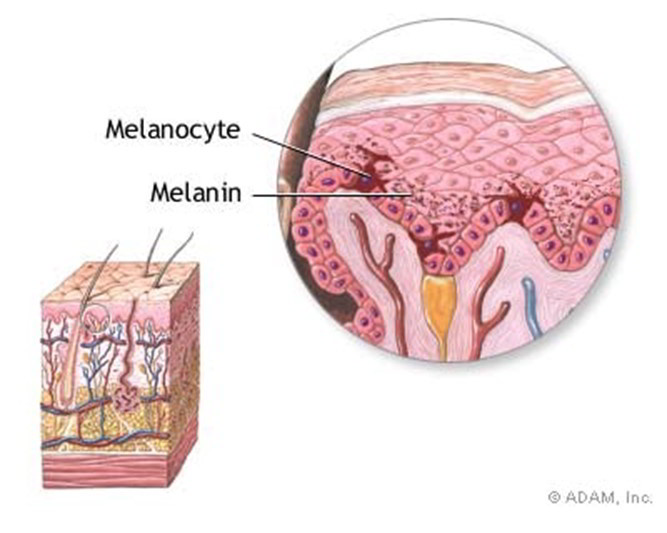Skin color results from the interaction of three different pigments: hemoglobin, carotene, and melanin. Hemoglobin (hemo-glo “-bin) is the red pigmented protein in red blood cells that is used to carry oxygen and carbon dioxide in the blood. Carotenes (kair-o-tens) are a group of lipid-ioluble plant pigments that range in color from violet, to red-yellow, to orange-yellow. Beta-carotene, which is the most abundant carotene, is found in yellow-orange and green leafy fruits and vegetables. The human body uses carotenes for vitamin A production, which is needed for the maintenance of epithelial tissues. Excess carotenes are stored in and add color to the body’s fatty areas, such as the subcutaneous tissue, and the stratum corneum. Melanin (mel-ah-nin) is a brown-black pigment that is formed by melanocytes. Melanocytes insert melanin into adjacent keratinocytes where it forms a protective UV radiation shield over their nuclei.
Most people have the same number and distribution of melanocytes. Generally, melanocytes are equally distributed throughout the epidermis. However, there are areas that have higher numbers of melanocytes and, as a result, greater amounts of melanin and darker coloring. Areas of the skin subjected to more sun exposure, such as the face, neck, and limbs, have greater numbers of melanocytes to provide more UV protection to these areas. Greater melanocyte numbers are also found in structures such as the areola surrounding the nipple and the external genitalia, creating darker coloration in body areas that indicate reproductive readiness. Also, melanocytes can occur randomly in small clumps and create freckles due to the concentration of melanin in small patches.
The amount of melanin that a person can produce is determined genetically. Some people are genetically predisposed to make melanin at a faster rate, which results in a darker skin color. Other people are predisposed to make melanin at a slower rate, which results in a lighter skin color. A person’s rate of melanin production can be influenced by exposure to UV radiation. Exposure to UV radiation will increase melanin production and produce a tanned appearance in lighter-skinned individuals. The increased melanin production is a protective, homeostatic mechanism. When exposure to UV radiation decreases, melanin production also decreases and the tan is lost in a few weeks as the “tanned” cells migrate to and are sloughed off the stratum corneum.
The skin colors characteristic of the various human races result primarily from varying amounts of carotene and melanin in the skin and are inherited. The effect of hemoglobin is relatively constant, but it is often masked by high concentrations of melanin. Dark-skinned races produce abundant melanin and have a greater protection from UV radiation. Caucasians produce relatively little melanin and are more susceptible to the harmful effects of UV radiation. The reduced amount of melanin in light-skinned Caucasians allows the hemoglobin of blood within dermal blood vessels to show through and give the skin a pinkish hue. Some people of Asian descent have a yellowish-tinged skin color due to the presence of a different form of melanin.
For Clinical Purpose
Physicians have known for a long time that the UV radiation in sunlight produces damaging changes in the skin. The damage is cumulative, although a single day’s exposure can produce noticeable changes. Short-term changes include sunburn and a tan as the body tries to protect itself from UV radiation by producing more melanin. Long-term UV damage ranges from increased wrinkling and loss of elasticity to liver spots and skin cancer.
Because the long-term effects of UV radiation do not appear for a number of years, the summer tans so important to some people will accelerate aging of the skin and may produce skin cancers in later life. The advent of tanning salons only increases potential problems for unwary users.
Skin cancer is by far the most common type of cancer. Fortunately, most skin cancers are carcinomas involving basal or squamous cells and are usually curable by surgical removal. However, melanoma, cancer of melanocytes, tends to spread rapidly to other organs and can be lethal if it is not detected and removed in an early stage. Melanoma is fatal in about 45% of the cases.
The undesirable effects of overexposure to UV radiation can easily be prevented by reducing the exposure of the skin to sunlight and by the liberal use of sunblock. UV radiation is at its peak between 11:00 A.M. and 3:00 P.M., so avoiding exposure during these hours is especially helpful.
Sunblock is available with different levels of protection, and they are labeled according to the sun protection factor (SPF) provided. This allows for the selection of a sunblock that is appropriate for a particular type of skin and duration of exposure. For example, sunscreens with an SPF of 30 or higher are available for fair-skinned persons who burn easily. Sunblock with an SPF of 15 may give adequate protection for olive-skinned persons who rarely burn.
Because of its deadly nature, the American Cancer Society has devised the “ABCD rule” for distinguishing malignant melanoma from a mole: A for asymmetry (one side has a different shape than the other); B for border irregularity (the border is not uniform); C for color (color is not uniform, often a mixture of black, brown, tan, or red); D for diameter (more than % inch).


 (52 votes, average: 4.70 out of 5)
(52 votes, average: 4.70 out of 5)